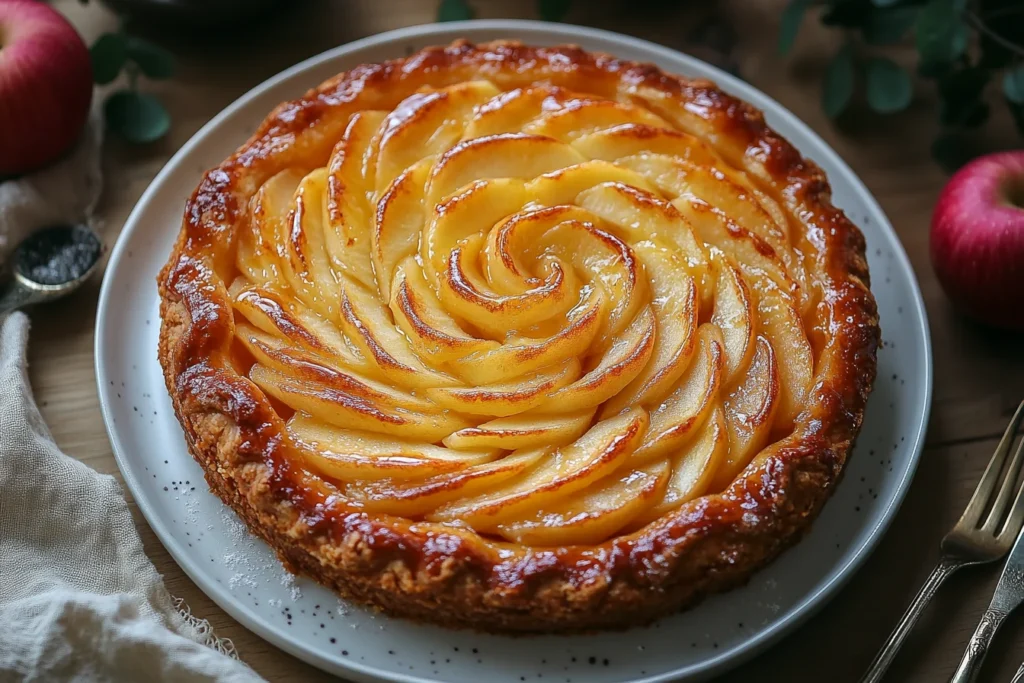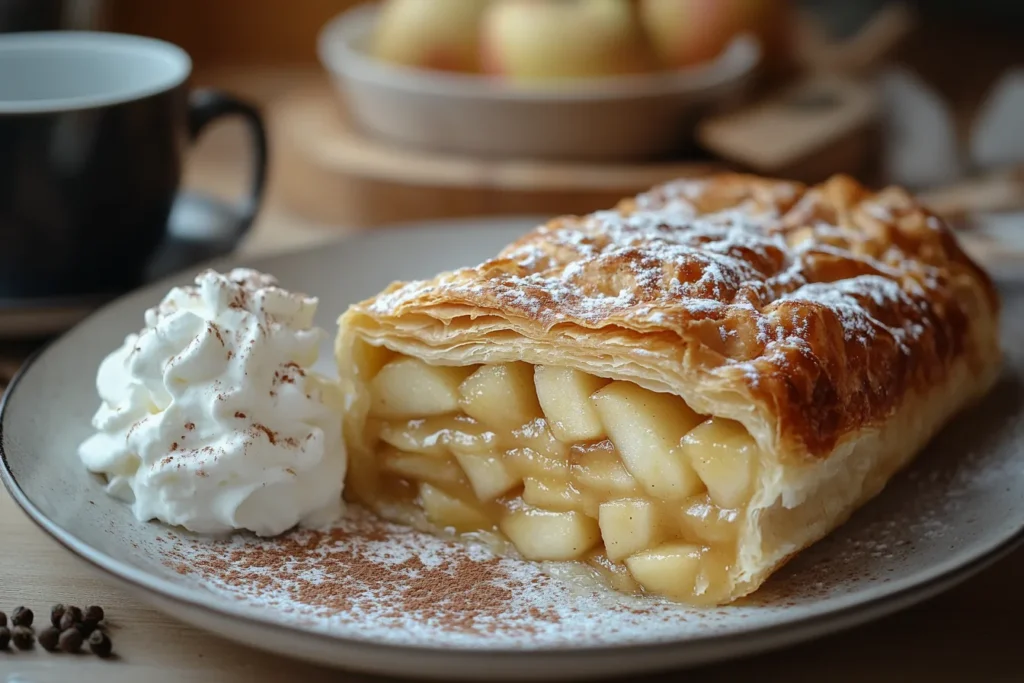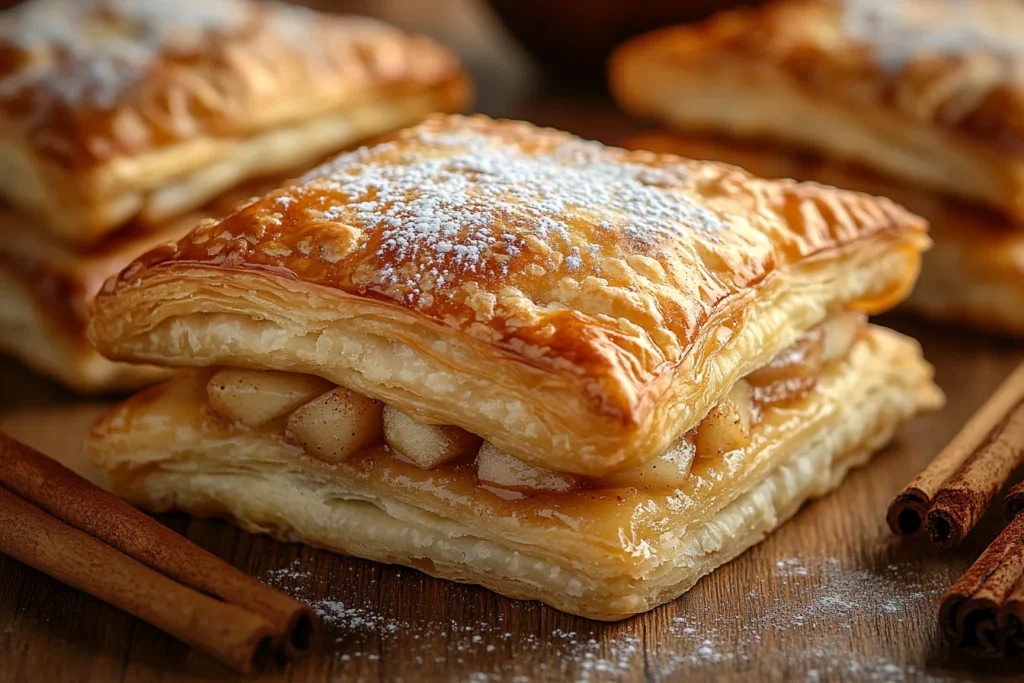What Is Another Name for Apple Pastry?
If you’re anything like me, apple pastries bring up cozy memories of warm kitchens, the smell of cinnamon, and, let’s face it, trying not to eat the entire batch in one sitting. But here’s a fun twist: there isn’t just one name for apple pastries. Depending on where you are or who you’re talking to, these flaky, fruity treats might go by different names. From “apple turnover” to “strudel” and even “apple pie,” each version has its own flair.
Curious about how apple pastries are enjoyed around the globe? Check out Master the Art of Japanese Apple Pastry Recipes to learn about unique twists, like whether they have apple pie in Japan.
Let’s dig into this apple-scented mystery and figure out what other names these delightful desserts go by! Spoiler: you’re probably going to crave a bite by the end of this.

Table of Contents
Understanding Apple Pastries
If you want a wholesome comfort food, nothing compares to a freshly baked apple pastry. The combination of flavorful apples and buttery and flaky apples is simply amazing! Across the globe, apple pastries are enjoyed in different versions according to different cultures. The basic concept is simple: a pastry dough (usually made with flour, butter, and sugar) wrapped around or layered with a filling of apples, sugar, and warm spices like cinnamon and nutmeg.
One common name is the apple turnover, a handheld pastry folded over to hold the apple filling, perfect for on-the-go snacking. Then there’s the apple strudel, a European favorite with thin, delicate layers of dough rolled tightly around the filling. And let’s not forget the classic apple pie, which can technically count as an apple pastry, thanks to its rich crust.
In many places, you’ll hear them called Danish pastries, especially when the dough is enriched and the apples are paired with custard. You might even run into regional variations, like tarts, galettes, or empanadas stuffed with apples.
The wonderful thing about apple pastry is the moderation. It seems like apples are sweet, spices are hot and dough is satisfying and all together makes it into a spell. Plus, they’re incredibly versatile you can enjoy them warm with a scoop of vanilla ice cream, or pack one up for a cozy lunchbox treat.
Whether you call it a turnover, strudel, or tart, one thing’s for sure: apple pastries are a sweet bite of happiness in every culture!
The Origins of Apple Pastry
Apple pastries have a rich history that spans centuries and continents. These sweet treats trace their roots back to the earliest days of baking, when apples and grains were among the most accessible ingredients for creating desserts. The concept of wrapping fruit in dough started as a practical way to preserve the fruit and create portable meals or snacks.
One of the earliest forms of apple pastry is the strudel, which emerged in Eastern Europe, particularly in Austria and Hungary. Strudels were influenced by Middle Eastern baklava, using thin layers of dough filled with spiced fruit. Meanwhile, in France, delicate puff pastry techniques gave rise to tarts, including apple variations, which were often glazed for a shiny finish.
Over in Britain, the apple pie became a staple in the medieval era, thanks to the availability of local apples. The original pies were more about preservation than indulgence; the crusts, known as “coffins,” weren’t even meant to be eaten! As sugar became more widely available, the recipes evolved into the sweet desserts we know today.
The apple turnover, a portable version of apple pastry, likely developed as a convenient variation for those on the move. Its simplicity and versatility allowed it to spread across Europe and eventually to the Americas, where it became a favorite bakery staple.
Regional Variations of Apple Pastry
Apple pastries may be a universal favorite, but every region puts its own delicious twist on them. From flaky folds to intricate layers, these treats reflect the culture and culinary traditions of their origins. Let’s take a bite out of some of the most popular regional variations!
- Apple Strudel (Austria and Central Europe)
Perhaps the most famous apple pastry, apple strudel is a masterpiece of Central European baking. It features paper-thin layers of dough rolled tightly around a filling of spiced apples, raisins, and breadcrumbs. Often served warm with powdered sugar and a dollop of cream, it’s a dessert that embodies Old-World charm. - Tarte Tatin (France)
The French take apple pastries to a new level with the tarte Tatin. This upside-down tart caramelizes apples in butter and sugar before being baked under a buttery crust. It’s flipped before serving, revealing glossy, golden apples on top. - Apple Turnover (Global)
Known as chausson aux pommes in France, the apple turnover is a simple pastry stuffed with apple filling and folded into a triangle or crescent shape. Popular worldwide, it’s perfect for breakfast or an afternoon treat. Variations can include puff pastry, shortcrust, or phyllo dough. - Apple Empanadas (Latin America)
In Latin American kitchens, apple empanadas are a beloved treat. Made with tender dough and a spiced apple filling, these pastries are baked or fried for a golden finish. They’re often sprinkled with cinnamon sugar for extra sweetness. - Dutch Apple Tart (The Netherlands)
The Dutch apple tart is a deeper pie-style dessert filled with sliced apples, cinnamon, and sometimes raisins or nuts. It’s characterized by a lattice crust and served with whipped cream or ice cream. - Swedish Äppelkaka (Sweden)
Though more cake-like, the äppelkaka combines the flavors of apple and cinnamon with a rich pastry base. It’s a staple in Swedish coffee breaks, known as fika.
Key Ingredients in Apple Pastries
The magic of apple pastries comes down to a handful of simple, yet perfectly balanced, ingredients. These components work together to create that familiar, comforting flavor and texture that keeps us coming back for more. Let’s break down the essentials!
- Apples
The star of the show! Apples bring natural sweetness, a hint of tartness, and that unmistakable fruity flavor. Varieties like Granny Smith, Honeycrisp, or Braeburn work best because they hold their shape during baking and deliver the perfect balance of sweet and tangy. - Flour
Flour forms the base of the dough, whether it’s for a flaky puff pastry, tender shortcrust, or delicate strudel layers. It gives the pastry its structure and holds everything together. - Butter
Butter is the heart of a good pastry, adding richness and creating that melt-in-your-mouth texture. For layered pastries like turnovers or strudels, cold butter is essential to achieve those beautiful, flaky layers. - Sugar
A touch of sweetness is key to enhancing the flavor of both the pastry and the apple filling. Brown sugar is often used for its caramel-like depth, while granulated sugar provides a cleaner sweetness. - Spices
Warm spices like cinnamon, nutmeg, and cloves give apple pastries their cozy, comforting aroma. They pair perfectly with the natural sweetness of the apples and create that signature flavor. - Lemon Juice
A splash of lemon juice brightens the apple filling, balancing the sweetness and preventing the apples from browning as you prepare them. - Eggs
Eggs help bind the dough and add richness to the pastry. They’re also used as an egg wash for a shiny, golden-brown finish. - Optional Add-Ins
Some recipes include extras like raisins, nuts, or a drizzle of caramel for extra texture and flavor. These little additions can take a simple apple pastry to the next level.
Popular Types of Apple Pastries
Apple pastries may be large apple and small, rough and smooth, simple and decorated – in fact, they may be anything one could dream of. Perhaps you want a buttery, melt in your mouth texture, or sweet and tangy with some apple compote, or decadent with caramel and apples, there an applesy goodness for all. Alright! Let’s take a closer look at the most typical offers!
- Apple Turnovers
These handheld treats are a classic favorite. Made with puff pastry or shortcrust dough, turnovers are folded over sweet apple filling and baked until golden and crispy. They’re portable, easy to make, and perfect for breakfast or dessert. - Apple Strudel
A Central European delicacy, apple strudel is all about layers. Thin sheets of dough are rolled around a filling of apples, sugar, cinnamon, and sometimes raisins. It’s baked to perfection and often dusted with powdered sugar or served with whipped cream. - Apple Pie
A quintessential American dessert, apple pie features a buttery, flaky crust packed with spiced apple filling. Whether topped with a lattice crust, a full crust, or crumbles, this dessert is a slice of nostalgia on every plate. - Tarte Tatin
It is an inverted French pastry – literally! Apples are cooked in butter with some sugar, put in an oven with a lid on top. They are turned upside down just before being served so that the apples are glistening, sinfully golden, shiny and tasty. - Danish Pastries with Apple Filling
Danish pastries contain layers of dough laminated with butter; apples are used as the filling for the pastry often with custard or icing topping. Many of these pastries are tender with a crispy layer and go well when teamed with coffee. - Apple Empanadas
In Latin American cuisine, apple empanadas are a must-try. These turnovers are filled with spiced apples, then baked or fried until golden brown. They’re often finished with a sprinkle of cinnamon sugar for extra sweetness. - Apple Galette
A galette is a rustic, free-form tart that lets the apples shine. The dough is folded casually around the filling, giving it a homemade, artisanal look and feel. - Dutch Apple Tart
This deep-dish delight features spiced apple filling topped with a lattice crust or crumbly streusel. It’s heartier than a pie and often served with whipped cream or ice cream. - Apple Dumplings
These comforting treats wrap whole apples in dough, bake them in a sweet syrup, and serve them warm. They’re as cozy as dessert gets!

How to Make Apple Pastry at Home
It is very convenient to make apple pastries at home, and each time you get the best results for the effort. Whether you are going for turnovers or strudel or even a galette which is almost homely by comparison, the method is fairly basic; and it depends on a few key components and a few key moves. Let’s get started!
Ingredients You’ll Need:
For the pastry:
2 cups all-purpose flour
1 cup cold butter (cubed)
1/4 cup ice water
1/4 teaspoon salt
1 egg (for egg wash)
For the apple filling:
3 medium apples (Granny Smith or Honeycrisp)
1/4 cup brown sugar
1 teaspoon cinnamon
1/4 teaspoon nutmeg (optional)
1 tablespoon lemon juice
1 tablespoon all-purpose flour (to thicken)
Step-by-Step Instructions:
Make the Dough:
In a bowl, mix the flour and salt in equal proportions. Put in the cold butter and use a pastry cutter or fork to break the butter into the flour until the mixture resembles coarse crumbs. Slowly pour in the ice water one tablespoon at a time while stirring until the dough binds together. Cover the dough in the plastic wrap and place in the refrigerator for half an hour.
Prepare the Filling:
Peel, core, and dice the apples into small chunks. Toss them in a bowl with brown sugar, cinnamon, nutmeg, lemon juice, and flour. Set aside to let the flavors meld.
Roll Out the Dough:
On a lightly floured surface, roll out the chilled dough to about 1/8-inch thickness. Cut it into squares (for turnovers) or leave it whole for a galette.
Assemble Your Pastries:
For turnovers: Place a spoonful of apple filling in the center of each square. Fold the dough over to create a triangle, sealing the edges with a fork.
For a galette: Spread the filling in the center, leaving a 2-inch border. Fold the edges over the apples, overlapping slightly.
Brush and Bake:
Beat the egg with a splash of water and brush it over the pastry for a golden finish. Place the pastries on a parchment-lined baking sheet and bake at 375°F for 20-25 minutes, or until golden brown.
Cool and Serve:
Let your pastries cool slightly before serving. They’re perfect with a dusting of powdered sugar or a scoop of vanilla ice cream!
Quick Tip: If you’re short on time, use store-bought puff pastry or pie crust instead of making the dough from scratch. It’s a lifesaver for weeknight baking!
Enjoy the warm, spiced goodness of your homemade apple pastries you’ve earned it!
Nutritional Information of Apple Pastries
Apple pastries are a delicious treat, but they’re also indulgent, so it’s helpful to know what you’re biting into. The exact nutritional content can vary depending on the recipe and portion size, but here’s a general breakdown for a standard apple turnover or similar pastry (about 1 serving, 100g):
Calories:
Approximately 250–300 calories
Most of the calories come from the buttery pastry dough and sugary filling.
Carbohydrates:
35–40g
The majority of the carbs come from the flour in the dough and the natural and added sugars in the apple filling.
Sugar:
15–20g
This includes the sugar added during preparation as well as the natural sugars from the apples.
Fat:
12–15g
Most of the fat content comes from butter used in the dough, making it rich and flaky.
Protein:
2–4g
The protein comes mainly from the flour and any eggs used in the dough or as a wash.
Fiber:
2–3g
The apples contribute a small amount of fiber, especially if the skin is left on.
Sodium:
200–250mg
This depends on the amount of salt added to the dough and any pre-made components used.
Tips for Making Healthier Apple Pastries
If you want to enjoy apple pastries with less guilt:
Use whole wheat flour instead of all-purpose for more fiber.
Reduce sugar in the filling and let the natural sweetness of the apples shine.
Try a lower-fat dough, like phyllo, to cut back on butter.
Opt for baking instead of frying, which reduces added fats.

FAQs About Apple Pastries
What type of apples are best for apple pastries?
Granny Smith, Honeycrisp, or Braeburn apples are great choices. They hold their shape during baking and have a sweet-tart balance.
Can I use store-bought pastry dough?
Yes! Puff pastry or pie crust from the store works perfectly for a quick and easy option.
How should I store apple pastries?
Store in an airtight container at room temp for up to 2 days or in the refrigerator up to 5 days. Best texture when reheated in the oven.
Can I freeze apple pastries?
Absolutely! Freeze them before or after baking. If unbaked, bake straight from frozen, adding a few extra minutes to the baking time.
What is another name for apple pastry?
Apple pastries go by names like apple turnover, strudel, or even apple pie, depending on the recipe and region.
Are apple pastries easy to make at home?
Yes! With basic ingredients like apples, dough, and spices, you can whip up apple pastries easily, especially using store-bought pastry.
Can apple pastries be made without butter?
yes, adding plant based substitutes like coconut oil or vegan margarine for dairy free apple pastries.
Conclusion: Why Apple Pastries Are Timeless Treats
Apple pastries are more than just desserts they’re an ode to simplicity and warm senses. No matter you are enjoying each bite in a crimped turnover, a country galette, or even buttery strudel, the sweet-spicy flavor and childhood memories fill our mouth. These pastries have been around not because they’re fancy, but because they’re social, versatile, and are baked love in a way.
So, the next time you crave something cozy, remember: apples , especially when baked in pastries are always a brilliant idea!

